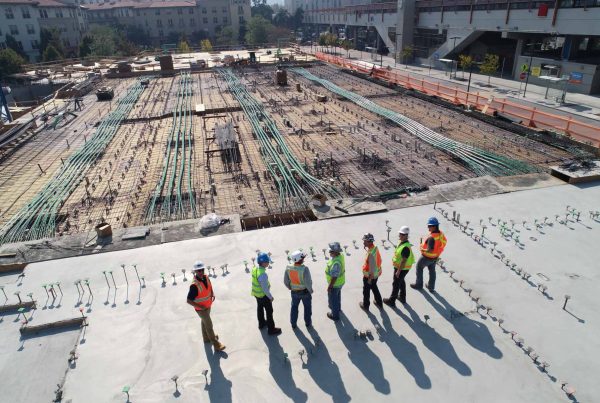Take a moment and close your eyes. Think of Lincolnshire. It is likely your imagination conjures up images of golden fields, of course, and perhaps some rural idyll, the iconic Lincoln Cathedral, historic market towns or large, green agricultural machinery.
 But set below the surface of the county, in every aspect of our daily lives, are the invisible underpinnings of our modern world: the innovation, engineering expertise and problem-solving of the civil engineering sector.
But set below the surface of the county, in every aspect of our daily lives, are the invisible underpinnings of our modern world: the innovation, engineering expertise and problem-solving of the civil engineering sector.
It is an industry that keeps our infrastructure building, maintains existing structures and ensures that essential services like clean water keep flowing from our taps. Civil engineering is also responsible for tackling many of the unique challenges faced by our county every day. Here is our breakdown of everything civil engineering in Lincolnshire.
The ground
Lincolnshire’s geology and topography are both a benefit and a challenge to civil engineers.
Unforgiving ground: The Fens and coastal areas are low-lying and prone to flooding, while the Wolds area, Lincoln and many of the county’s market towns are hilly with steep-sided valleys. Combined with the county’s weighty agricultural and industrial history and high water table in places, it makes for unforgiving ground for many projects.
Working with water: Lincolnshire is a county on the frontline of coastal and tidal flood defences. The Environment Agency leads much of this work, but civil engineers and contractors are on the front line too, maintaining existing defences and building new ones to protect homes and agriculture across the county.
A working landscape: Lincolnshire is the largest county in the UK by area and the home of the UK’s largest agricultural output. The engineering requirements to support and service this output are vital to the local economy and range from designing and building effective drainage and systems in the Fens to connecting the region’s goods with high-capacity trunk roads.
Big projects and the people behind them
Lincolnshire has also seen its fair share of large-scale projects in the civil engineering field in recent years. Here are some of the most significant projects to look out for in the near future:
Lincoln Eastern Bypass: It may have taken three decades, but the Lincoln Eastern Bypass is finally on its way after years of planning, delay, council disbanding and funding.
To be clear: this is a big-deal project. It will ease congestion in the city centre, reduce carbon emissions and air pollution, create new jobs and help connect Lincoln’s eastern with the rest of the county to the east of the city.
The £120 million bypass will open this year and should be fully completed by the end of 2023. It is set to provide shorter journey times, create local jobs, ease congestion and better connect Lincoln’s eastern with the rest of the county to the east of the city.
The Boston Barrier: Another significant recent project has been the mammoth Boston Barrier tidal flood gate project, now in full swing after lengthy planning and consultation. This project by the Environment Agency will feature the longest tidal flood barrier in the UK when completed in the next few years. It will protect 14,000+ properties in Boston from tidal surges, both today and well into the future.
Engineering staff can expect an exciting project with an international best-practice design from the lead engineer Jacobs. In a project of this nature and scale, there is likely to be long-term and well-paid employment in many supporting roles.
Offshore wind: wind energy is set to be a big area for Lincolnshire civil engineers in the coming years, too, with new renewable energy networks coming on stream off the county’s coast. Again, one word: infrastructure. Connecting these new wind farms to the national grid, providing power for millions of homes, is a massive task that relies on civil engineers to build and design all the onshore substations and 3D underground cabling networks.
Agriculture: thousands of engineering civil jobs in Lincolnshire focus on supporting the primary industries of the county. From drainage to water management to internal transport networks on large estates and farms, this is also a sector to keep a close eye on.
Local firms
Lincolnshire is home to hundreds of civil engineering companies. From established local contractors with national reputations to specialists in niche sectors, the county has a great choice of highly-qualified professionals and businesses.
In this country, civil engineering is dominated by SMEs but supplemented by a number of larger national and international firms with offices in the county. The local industry provides a great opportunity to work with some of the best people in the sector while not having to move hundreds of miles to work in London, the South East, or Scotland.
Areas of expertise for Lincolnshire-based civil engineering firms include:
- Groundworks and other infrastructure and project management roles on new commercial and residential developments.
- Highway and transportation engineering.
- Drainage and water management.
- Structural engineering, including restoration.
Lincolnshire has many strong civil engineering firms and with a large pool of recent university graduates, great opportunities to work with and support these companies as apprentices, graduates or as fully qualified staff members. Of course, many of these firms also offer engineering roles within their construction companies to help staff through qualification and upskilling in civil, structural and other engineering disciplines.
The future
Climate change, sustainability and investment in new green energy infrastructure will continue to be the big driver for Lincolnshire civil engineers for some years to come.
Lincolnshire has significant low-lying land, especially in the Fens and coastal areas, which means climate resilience will also be an important area of expertise for many civil engineers. Nature-based flood management and control solutions and green infrastructure are likely to be a focus, in conjunction with more traditional hard defences.
Sustainable construction is also set to be key with low-carbon concrete, recycled and reusable materials, and more energy-efficient designs high on the agenda as the construction sector works towards net zero by 2050.
Building Information Modelling (BIM), drones and AI are all becoming more commonplace in civil engineering roles and are likely to make projects safer, quicker, and more cost-effective than ever before.
So next time you pass through a new roundabout, drive along a smooth, tarmac road surface or find yourself safe from a tidal surge during high tide, spare a thought for the civil engineers and construction professionals designing and building the Lincolnshire beneath our feet.
They’re building the future for us all, quite literally, beneath our feet.



